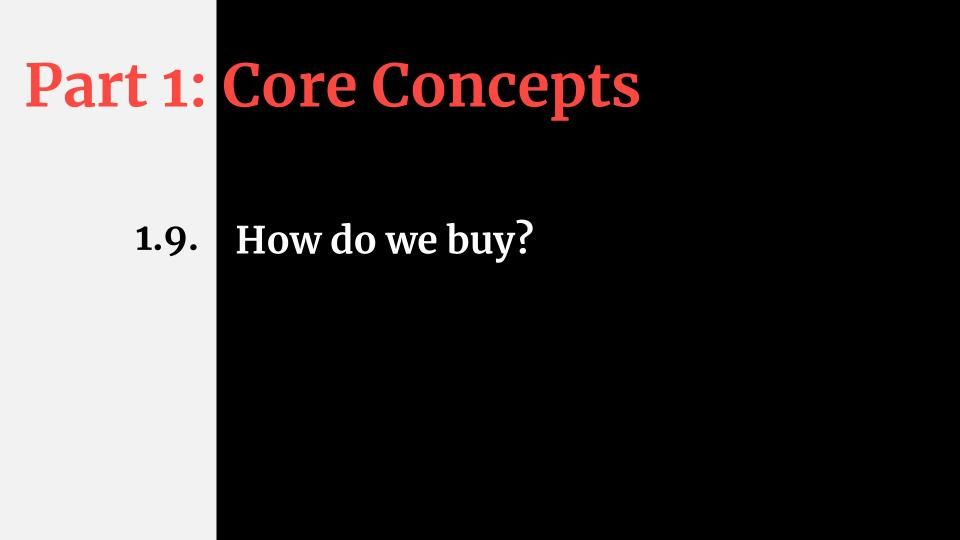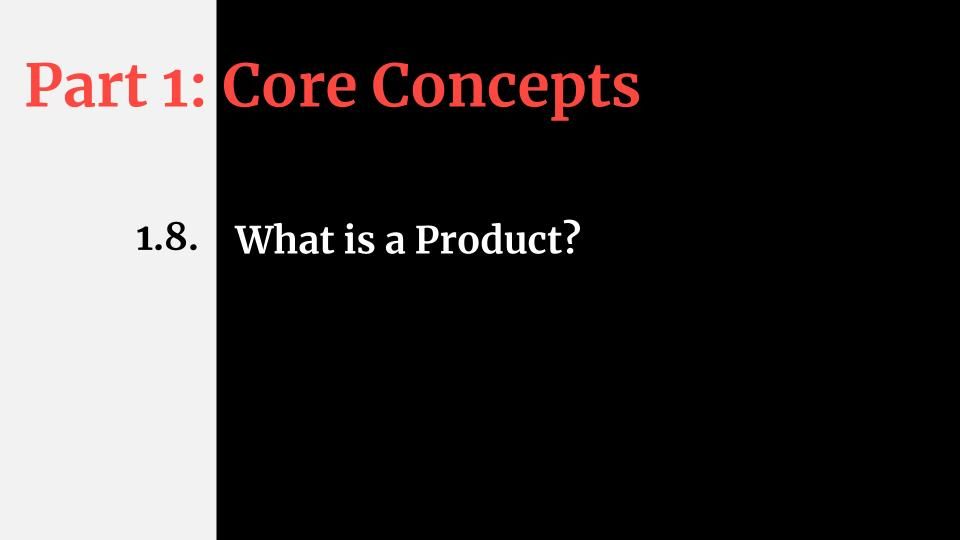1.9. How do we buy?

Companies are obsessed with building effective sales strategies and processes. The goal is to ensure that the company can scale faster and sell more efficiently. The danger comes when we try to optimize the sales process without understanding how customers buy or prefer to buy. Marketers need to rethink how to optimize for the buying process instead of the sales process.
The sales process focuses on the needs of your organization first, while the buying process focuses on customers and their journey of considering and acquiring products. When we reframe the transaction process as a buying process we focus on customer needs and preferences.
It's not enough to make your customers want your product. You have to make your product easy to buy. Designing the buying experience is as important as designing the product itself. The easier it is for a customer to buy your product the higher the customer satisfaction (source). This is why retail stores are not only concerned about their product selection and quality but also how the stores are designed. Is it easy for people to walk in? How do you position merchandise around the store? Amazon, for example, not only provides a great selection, low prices, and quick shipping but also allows customers to compare and buy products in the shortest time possible.
The buying experience is a major contributor to overall customer experience because buying is the first stage where customers interact with a company or product. If purchasing a product is difficult then just imagine how bad the support must be. If the buying experience sucks while vendors have a high incentive to put their best foot forward to get a customer, imagine how much worse it will get when your money hits their bank account. Yes, the risk of churn is a powerful incentive but the desire to close the deal is more immediate and desired.
B2B software companies used to be predominantly sales-driven before the software-as-a-service model was introduced. It required the buyer to speak at length with a sales rep to get product information. This sales-driven approach is also known as a high-touch model.
The subscription economy - with lower prices, ownership, and switching costs - has changed how customers buy. Companies made educational and product-related content more accessible to prospective customers as they searched for more efficient ways to generate product awareness and demand. Prospects could then find, learn, and compare software products earlier in the buying process, way before they interacted with sales. In this way, content marketing and lead generation were established as primary strategies for companies to generate awareness and demand.
The rise of content marketing and lead nurturing brought marketing automation solutions that promised, among other things, to calculate content marketing ROI. Lead nurturing is a process of continual communication with a prospect until he or she is ready to buy. The new marketing-led approach to customer acquisition promises to close the gap between marketing and sales. Marketing teams generate and nurture leads, while sales teams focus on prospects that are aware of a product and the problem it solves. A marketing-led approach has made SaaS companies far more efficient and effective. Eloqua, Marketo (now part of Adobe), and Hubspot are the most well-known examples of marketing automation companies that popularized a marketing-led strategy. When it comes to content marketing, Hubspot and Marketo set the standard. The amount of content created by these companies is startling.
Today, prospective customers progress far along in the buying process before talking to sales, making content strategy a given. Content marketing helps prospects recognize the problem and the need for the product while empowering them to evaluate alternatives and create a shortlist of potential solutions. Through content, buyers in the enterprise software market become more knowledgeable about industry products and trends. By the time your sales team interacts with a prospect, they can expect the prospect to have formed a perception of what your product does and available alternatives.
Let's break down customer buying behavior. What are the essential pieces that you need for the purchase to occur? First, the buyer has to be motivated. Under motivation, we can place rational, emotional needs and values that must be met for a buyer to make a decision. Second, the buyer needs a way to buy the product or service. The product must be available in their region. Buyers need to have the authority to make a purchase if we are talking about the B2B industry. The third element of the purchasing process is resources. Does the buyer have the resources or budget to complete the purchase? And a fourth, optional element is a trigger. Is there anything that happened with the customer that triggers a new need? For example, if you are hiring your first recruiter that could be a trigger to buy an applicant tracking system.
- Motivation = Desire
- Ability = Access
- Resources = Money / Budget
- Optional: Trigger = event that triggers buying actionBJ Fogg, founder of Behavioral Design Lab at Stanford University, developed a behavioral model that marketers can use when designing buying experiences (source). It provides a framework on how to create experiences that result in desirable behaviors.
Checkout my course on How to Conduct Customer Interviews
Read previous chapter


